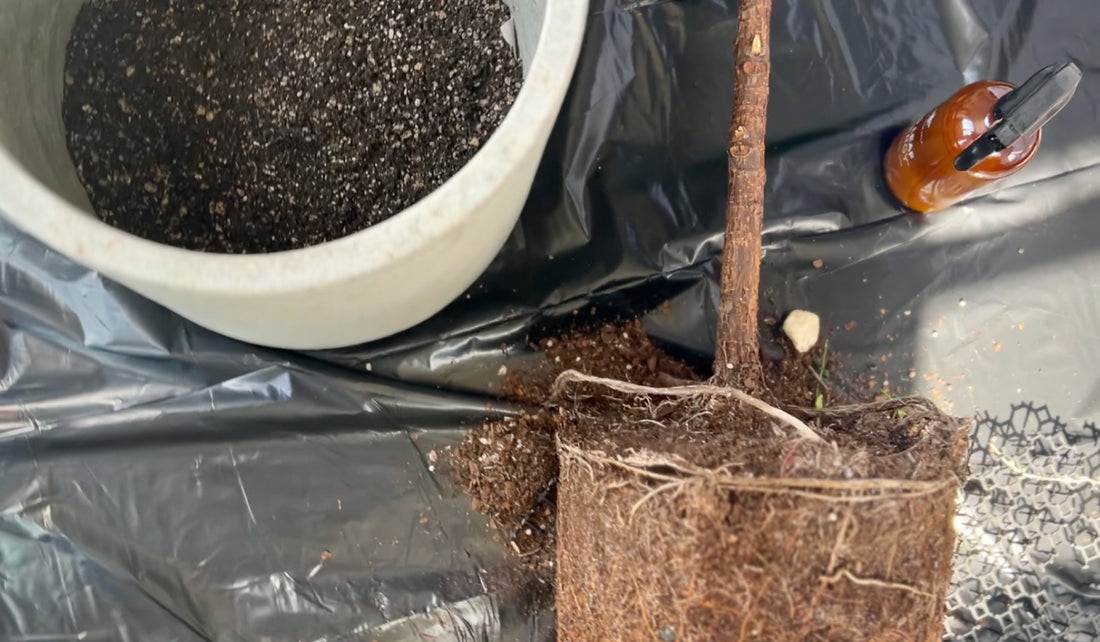
Welcome to our guide on when and how to repot your fiddle leaf fig! This can be an intimidating process with these trees as they are prone to shock. Whether you're a seasoned plant parent or a budding green thumb, understanding when and how to repot your beloved ficus lyrata can make all the difference in its growth and overall health long term.
In this article, we'll delve into the world of fiddle leaf fig repotting vs potting up, remediation for unhappy roots, preventing shock, and everything in between. So grab your favorite houseplant gardening tools, and let's get started!
How and When to Repot You Fiddle Leaf Fig Tree

Repotting vs. Potting Up:
Before we dive into the specifics, let's clarify the distinction between repotting and potting up. Repotting is a process reserved for when the soil is in poor condition or when the roots of your fiddle leaf fig require remediation due to some sort of pathogen or root rot. In this case, you'll remove all the soil and either place the plant back in the same pot or a larger one if necessary. On the other hand, potting up is a practice done when your fig tree has outgrown its current pot, usually after a couple of years of growth.
Repotting is a process reserved for when the soil or roots are in poor condition. Potting up should happen when your plant outgrows its pot.
Signs It's Time to Repot or Pot-Up Your Fiddle Leaf Fig:
Knowing when to repot your fiddle leaf fig is crucial for maintaining its health and promoting optimal growth. Here are a few signs to look out for:
-
Root Bound:
If it's been a couple years since you last potted-up, or if you notice roots circling around the bottom of the pot or protruding through drainage holes, it's a clear indication that your fig tree needs more space.
-
Slow Growth:
Is your fiddle leaf fig showing minimal growth or small leaves despite proper care? This is a sign to pot-up your plant. -
Spots appearing on mature leaves:
Signs of soil pathogens and root rot communicate through leaf discoloration, typically browning at the center or base of the leaf. This shouldn't be confused with edema which effects young leaves in early growth (these appear as slightly dark orange speckles and fade away as the leaf matures). -
Yellowing leaves:
This could be a sign of poor soil pH or poor nutrient uptake if your plant is root bound.
Potting Up: Giving Your Fig Tree Room to Grow:
Potting up your fiddle leaf fig is a process that allows the plant to flourish in a larger space, accommodating its increasing root system. Spring or summer is the ideal time for this endeavor, as your tree will be entering its active growing phase. Here's how you can pot up your fiddle leaf fig and help it avoid shock:
Spring or summer is the ideal time for potting up your plant.
-
Be Prepped and Ready:
Choose a new pot that is approximately 1-2 inches larger in diameter than the existing one. This provides ample space for the roots to expand without taking energy from foliar growth. Also, have your backfill soil ready to go to prevent excess air-time on your roots. -
Gently Removing from the Pot:
To avoid damaging the delicate trunk, gently slide the fiddle leaf fig out of its current pot. Avoid pulling it out forcefully, as this can harm the roots.
-
Loosening Bound Roots:
If you notice any tangled or bound roots, use a chopstick or your fingers to gently loosen them up. This encourages healthy root growth and prevents future complications. Try to avoid cutting the roots in at all possible. -
Give the Roots a Spa Refresh:
Take this opportunity to spray down the exposed roots with a product like Big Leaf Energy®. This neem and essential oil-based spray nourishes and protects the root system, promoting overall plant health. -
Replanting and Backfilling:
Place your fiddle leaf fig in the new pot and backfill it with a well-draining soil mix of your choice. Ensure that the soil is evenly distributed and gently press it down to provide stability. We prefer semi-hydroponic soils for the Fiddle Leaf Fig tree with little to no organic matter or added chemicals or slow release fertilizers. We love a good ratio of charcoal, pumice, LECA, and coir to allow good airflow and reduce decomposition for these permanent plant installations. -
Watering, Food, and Sunlight:
Help prevent shock by thoroughly watering with Fiddle Leaf Treats™, a specialized fertilizer. Then, place the plant in a bright spot with indirect sunlight to aid its recovery and growth, and don't move it again!
Repotting: Remediation for Unhappy Roots:
In certain cases, repotting becomes necessary to address issues with your fiddle leaf fig's roots. If you observe unhealthy roots or soil, it's time to give your plant a fresh start no matter what season. Here's how to repot your fiddle leaf fig the best way:
-
Gently Removing from the Liner Pot:
Carefully remove your fiddle leaf fig from its liner pot, taking care not to damage the roots. -
Inspecting Roots and Soil:
Examine the roots and soil for signs of distress. Discard any compacted or rotting soil, and trim away mushy or rotten roots if present. -
Spraying with Big Leaf Energy:
Spray the root system thoroughly with Big Leaf Energy®, harnessing the power of neem and essential oils to promote root health and prevent pests. -
Filling the Pot with Fresh Soil:
Fill the empty pot with a fresh, well-draining soil mix, preferably one with a low peat or low organic content to prevent decomposition and aid pest control. -
Placing the Root Ball and Backfilling:
Position the root ball on top of the new soil and backfill the pot with the remaining soil. Gently press the soil down to ensure stability and proper root contact. -
Watering and Placement:
After repotting, water your fiddle leaf fig thoroughly with Fiddle Leaf Treats™, providing it with the necessary nutrients. Place the plant in a bright spot, avoiding direct sunlight.

Repotting or potting-up your fiddle leaf fig is an essential part of its care routine, ensuring its well-being and growth. Whether you're potting up to give your tree room to flourish or repotting to address root issues, following these guidelines will help you navigate the process with confidence and prevent destabilizing your precious plant. Remember to observe signs of distress and provide the necessary care to keep your fiddle leaf fig thriving. So, grab your gardening gloves and embark on a repotting adventure that will leave your fig tree thanking you with lush foliage and vibrant growth!
Related: How to Get Your Fiddle Leaf Fig Tree to Fall in Love With You


